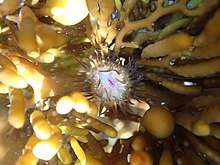Cricophorus nutrix
Cricophorus nutrix, commonly known as the brooding or nurse anemone, is a species of sea anemone endemic to New Zealand.[1]
| Cricophorus nutrix | |
|---|---|
 | |
| Scientific classification | |
| Kingdom: | |
| Phylum: | |
| Class: | |
| Order: | |
| Family: | |
| Genus: | Cricophorus |
| Species: | C. nutrix |
| Binomial name | |
| Cricophorus nutrix (Stuckey, 1909) | |
It is found living in colonies on the stem of large seaweed and kelp species in the low tidal zone.[2] It can also live in deep tidal pools where seaweed is present.[3]
Description
This small anemone has a diameter of 10–15 millimetres[3] with a range of colours that can appear to be iridescent.[2]
When underwater it extends short, fine, smooth tentacles that are 2–5 millimetres long with rounded tips. These are arranged in three to four crowded whorls along the edge of the disc.[2] The inner tentacles can be twice as long as the outer tentacles.[4] Tentacle colour can range between light yellow and deep brown and often feature green, blue or red tinges.[3] Its central disc can be a similar colour to the tentacles or a contrasting colour such as white, purple or orange and usually features radial markings.[2] Its mouth can be light blue, bright pink or purple, and often has a lighter colour on the interior.[3] The anemone's column is usually a deep brown colour, but can also be green, blue, or yellow.[2]
Out of water, the tentacles retract and the anemone camouflages itself against the plant it is attached to.[3]
Behaviour
Brooding anemone release long, white threads of stinging cells when it is disturbed. This is a defence mechanism to deter attackers.[3]
References
| Wikimedia Commons has media related to Cricophorus nutrix. |
- "Anemone, Brooding". The Marine Life Database. Retrieved 22 April 2019.
- Stuckey, F.G.A. (1908). "A Review of the New Zealand Actiniaria known to Science, together with a Description of Twelve New Species". Transactions and Proceedings of the Royal Society of New Zealand 1868–1961. Retrieved 22 April 2019.
- Carson, Sally (2017). Field Guide to the New Zealand Seashore. Harper Collins. ISBN 978-1-7755-4010-6.
- Carlgren, Oskar Henrik (1924). "Actiniaria from New Zealand and its subantarctic islands" (PDF). Papers from Dr. Th. Mortensen's Pacific Expedition 1914–16. XXI.